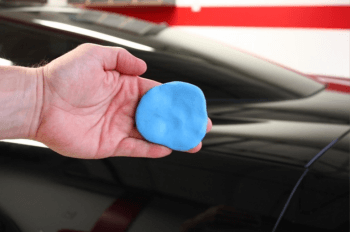How to apply Glass Coating
The successful application of a glass coating begins with the painstaking groundwork of cleaning the vehicle’s surface. Whether the coating being used on the exterior or interior of the car, the surface must be cleaned of dirt and pollutants so they do not get caught under the glass coating, which means it will not adhere properly, which will affect appearance. The surfaces must also be cleared of scratches and swirls for the best glossy appearance.
Preparation for glass coating

The preparation for glass coating is similar to that for ceramic coating. The surface being coating must be in good condition as well as clean, and dry. All oil, dust and other pollutants should be removed by washing it with car wash soap, rinsed off with water and when dry the use of a clay bar is recommended.
A claybar is a paint cleaner that removes grime that has bonded to the surface of paint and glass. When used properly a claybar itself never touches the paint but glides over it on a layer of cleaning fluid which means that the paint suffers no wear and tear in the process. A clay bar cannot remove swirl marks or scratches or improve the shine, but it will clean the car perfectly and swiftly.
Cleaning wheels with a claybar can remove stains such as brake dust which can be difficult to remove even with the strongest cleaners. It is suggested that claybars only be used on wheels that have a factory clearcoat or powder coat finish. Claybar also works well on glass and chrome.
Once you have finished with the claybar, clean the surface with ethanol using a microfibre cloth to ensure the area is ready for the glass coating. When you have finished cleaning the surface of dirt and pollutants, remove paint swirls, scratches and other marks by polishing with an abrasive compound.
Use masking tape to protect areas that you do not want coated. Do a spot test on the car first.
Application for glass coating
Glass coatings come in a range of bottles, sprayers, syringes and more, depending on the brand. There are also glass coating kits complete with microfibre cloths and applicators.
The application is much easier for glass coating than for ceramic coating. This is for several reasons. First, there are no toxic particles in a glass coating, so there is little odour. Secondly, the ideal temperature for application of a glass coating is broad, being between 7° C and 40° C (45° F and 105° F) with relative humidity 90% or less.
However, make sure to work in small areas because the product hardens as soon as it comes into contact with air.
The container of liquid must be shaken for several minutes to re-suspend the nanoparticles that will have settled to the bottom. The container must be reshaken every 15-20 minutes to ensure optimum coating.
Saturate a microfibre cloth with the solution and in a criss-cross pattern, going both horizontally and vertically, wipe a thin coat onto the surface, making sure the area is totally covered. use an applicator to work it evenly into the surface.
Let the coating dry for between two and five minutes, then buff out any slight hazing with a clean microfibre cloth.
The methods are the same for interiors where a glass coating stops dry dirt sticking to the surface which has been treated. For a coating 500 times thinner than a human hair, this is a remarkable achievement.
Leave the car in a place where it cannot be affected by contaminants or by humidity for at least 24 hours so that the glass coating can cure before the car is taken outside. If this is difficult, it may be simpler to get the job done by professionals.
Cleaning glass coatings
Glass coated exteriors can be cleaned by the simple use of a garden hose with a sprayer. If cleaning in an interior, clean with a damp towel rinsed with fresh water and then dry. There are specialist cleaning agents for more stubborn dirt or stain removal. To reapply, you do not need to strip off the original coat, but instead just reapply another glass coating.